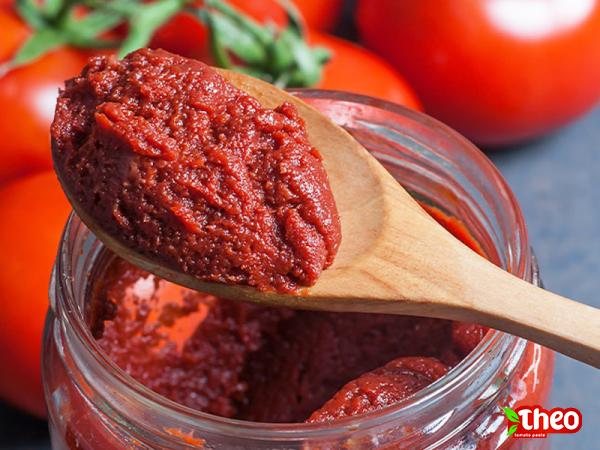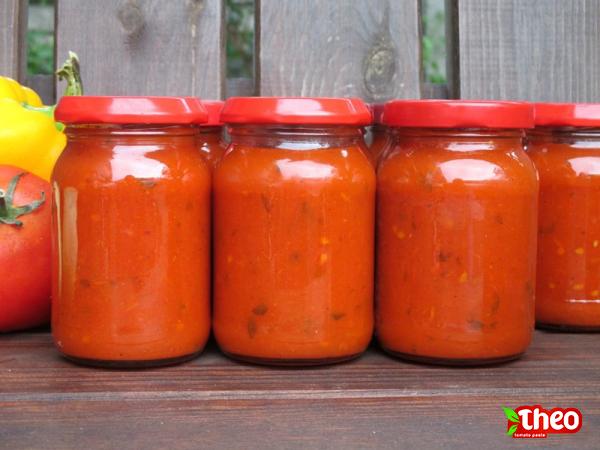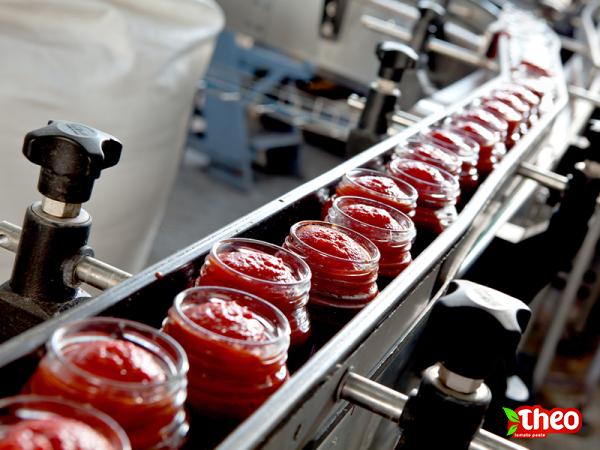Introduction: Tomato paste, a thick and concentrated form of tomatoes, offers a multitude of benefits when used as a pasta sauce. With its rich flavor, intense color, and versatility, tomato paste has become a popular choice for enhancing the taste and texture of pasta dishes in cuisines across the globe. This summary aims to explore the various advantages, applications, and potential drawbacks of using tomato paste as a pasta sauce. Advantages of Tomato Paste as a Pasta Sauce: 1. Intense Flavor: Tomato paste contains a high concentration of tomatoes, which results in a deep and robust flavor. Its concentrated nature enhances the taste of pasta dishes, providing a satisfying umami kick. 2. Long Shelf Life: Tomato paste, due to its dehydrated form, offers an extended shelf life compared to fresh tomatoes. This allows for convenient storage and transportation, making it a practical choice for home cooking and commercial applications. 3. Versatility: Tomato paste can be customized to suit various pasta sauce recipes. It serves as an excellent base ingredient that can be enhanced with spices, herbs, vegetables, or meat to create a wide range of flavors and textures. 4. Time Efficiency: As tomato paste is already cooked and reduced, it saves considerable cooking time compared to preparing tomato sauce from scratch. Busy individuals or restaurants can benefit from the convenience and efficiency it offers. 5. Economic Value: Tomato paste is considered a cost-effective option when compared to using fresh tomatoes. Its concentrated form requires smaller quantities to flavor a dish, resulting in long-term savings for both individuals and businesses. Applications of Tomato Paste as a Pasta Sauce: 1. Classic Marinara Sauce: Tomato paste forms the backbone of traditional marinara sauce, adding depth and richness to the dish. Paired with garlic, onions, and herbs, it forms a simple and delectable pasta sauce that complements a wide variety of pasta shapes. 2. Arrabbiata Sauce: Tomato paste can be spiced up with chili flakes, garlic, and olive oil to create a fiery arrabbiata sauce. The concentrated flavors of tomato paste add an intensity that balances well with the heat, creating a bold and flavor-packed pasta experience. 3. Bolognese Sauce: The richness of tomato paste, combined with ground meat, aromatic vegetables, and herbs, forms the base of a classic Bolognese sauce. It delivers a hearty and satisfying pasta dish that pairs exceptionally well with thick pasta shapes such as tagliatelle or pappardelle. 4. Puttanesca Sauce: Tomato paste serves as a key ingredient in puttanesca sauce, contributing to its bold and tangy flavor profile. The combination of tomato paste, olives, capers, chili flakes, and anchovies creates a robust pasta sauce that appeals to those who enjoy bold flavors.

tomato paste
 5. Creamy Tomato Sauce: Tomato paste can be incorporated into creamy pasta sauces to add depth and color. By combining it with cream, cheese, or coconut milk, tomato paste can create a velvety, indulgent sauce that coats the pasta beautifully. Potential Drawbacks and Considerations: 1. Salt Content: Some commercially available tomato pastes may contain high levels of salt as a preservative. It is essential to check the label and choose low-sodium options or adjust the overall salt content in the final dish accordingly. 2. Consistency: Tomato paste is initially thick and concentrated. Although this viscosity works well for most pasta dishes, some recipes might require a thinner sauce. In such cases, it is recommended to dilute the tomato paste with water, broth, or wine to achieve the desired consistency. 3. Acidity: Tomato paste, being highly acidic, might not suit everyone’s palate. To balance the acidity, adding a pinch of sugar or using other ingredients like cream, butter, or grated cheese can help mellow down the intense tartness. 4. Allergies and Sensitivities: Individuals with allergies or sensitivities to tomatoes should exercise caution when consuming tomato paste as a pasta sauce. It is advisable to consult a healthcare professional in such cases. Conclusion: Tomato paste offers a versatile and flavorful alternative to traditional pasta sauces. Its concentrated nature, long shelf life, and cost-effectiveness make it an appealing choice for both home cooks and commercial establishments. Whether used as a base for classic marinara, arrabbiata, Bolognese, or creamy tomato sauces, tomato paste elevates the taste and texture of pasta dishes, providing a satisfying and delicious experience for pasta lovers worldwide.Title: Tomato Paste as a Versatile Pasta Sauce: Unlocking Business Opportunities
5. Creamy Tomato Sauce: Tomato paste can be incorporated into creamy pasta sauces to add depth and color. By combining it with cream, cheese, or coconut milk, tomato paste can create a velvety, indulgent sauce that coats the pasta beautifully. Potential Drawbacks and Considerations: 1. Salt Content: Some commercially available tomato pastes may contain high levels of salt as a preservative. It is essential to check the label and choose low-sodium options or adjust the overall salt content in the final dish accordingly. 2. Consistency: Tomato paste is initially thick and concentrated. Although this viscosity works well for most pasta dishes, some recipes might require a thinner sauce. In such cases, it is recommended to dilute the tomato paste with water, broth, or wine to achieve the desired consistency. 3. Acidity: Tomato paste, being highly acidic, might not suit everyone’s palate. To balance the acidity, adding a pinch of sugar or using other ingredients like cream, butter, or grated cheese can help mellow down the intense tartness. 4. Allergies and Sensitivities: Individuals with allergies or sensitivities to tomatoes should exercise caution when consuming tomato paste as a pasta sauce. It is advisable to consult a healthcare professional in such cases. Conclusion: Tomato paste offers a versatile and flavorful alternative to traditional pasta sauces. Its concentrated nature, long shelf life, and cost-effectiveness make it an appealing choice for both home cooks and commercial establishments. Whether used as a base for classic marinara, arrabbiata, Bolognese, or creamy tomato sauces, tomato paste elevates the taste and texture of pasta dishes, providing a satisfying and delicious experience for pasta lovers worldwide.Title: Tomato Paste as a Versatile Pasta Sauce: Unlocking Business Opportunities
Specifications of tomato paste
 Introduction: Tomato paste has emerged as a popular choice for pasta sauce due to its intense flavor, long shelf life, versatility, and economic value. In addition to its culinary advantages, tomato paste offers numerous business opportunities in the food industry. This article delves into the potential business applications and strategies for utilizing tomato paste as a pasta sauce. 1. Manufacturing and Distribution: When considering tomato paste as a pasta sauce, the manufacturing and distribution aspects play a crucial role. Entrepreneurs can explore opportunities by setting up small-scale tomato paste production units or partnering with existing manufacturers. This allows for greater control over the quality, flavor, and packaging of the product. Additionally, establishing distribution networks to supply tomato paste as a pasta sauce to grocery stores, specialty food retailers, and restaurants can create a steady revenue stream. 2. Private Labeling: Private labeling is a viable strategy for businesses looking to enter the tomato paste pasta sauce market. By collaborating with manufacturers or co-packers, companies can create their unique brand and packaging while utilizing high-quality tomato paste. Private label products offer differentiation and exclusivity, which can be leveraged as a selling point to attract customers who appreciate personalized food options. 3. Food Service Industry: The food service industry provides a significant opportunity for tomato paste as a pasta sauce. Restaurants, cafes, and catering companies can incorporate tomato paste-based sauces into their menu offerings, providing customers with flavorful pasta dishes. By focusing on the time efficiency and consistent quality of tomato paste sauces, businesses can streamline their operations and meet customer expectations for delicious pasta meals. 4. Retail and E-commerce: Retailers, both brick-and-mortar and online, can capitalize on the popularity of tomato paste as a pasta sauce by offering a variety of options to consumers. Partnering with tomato paste manufacturers or sourcing high-quality products can help retailers meet the growing demand for convenient and versatile pasta sauce options. E-commerce platforms provide an ideal avenue for retailers to showcase their tomato paste pasta sauces to a wider audience, expanding their customer base beyond regional boundaries.
Introduction: Tomato paste has emerged as a popular choice for pasta sauce due to its intense flavor, long shelf life, versatility, and economic value. In addition to its culinary advantages, tomato paste offers numerous business opportunities in the food industry. This article delves into the potential business applications and strategies for utilizing tomato paste as a pasta sauce. 1. Manufacturing and Distribution: When considering tomato paste as a pasta sauce, the manufacturing and distribution aspects play a crucial role. Entrepreneurs can explore opportunities by setting up small-scale tomato paste production units or partnering with existing manufacturers. This allows for greater control over the quality, flavor, and packaging of the product. Additionally, establishing distribution networks to supply tomato paste as a pasta sauce to grocery stores, specialty food retailers, and restaurants can create a steady revenue stream. 2. Private Labeling: Private labeling is a viable strategy for businesses looking to enter the tomato paste pasta sauce market. By collaborating with manufacturers or co-packers, companies can create their unique brand and packaging while utilizing high-quality tomato paste. Private label products offer differentiation and exclusivity, which can be leveraged as a selling point to attract customers who appreciate personalized food options. 3. Food Service Industry: The food service industry provides a significant opportunity for tomato paste as a pasta sauce. Restaurants, cafes, and catering companies can incorporate tomato paste-based sauces into their menu offerings, providing customers with flavorful pasta dishes. By focusing on the time efficiency and consistent quality of tomato paste sauces, businesses can streamline their operations and meet customer expectations for delicious pasta meals. 4. Retail and E-commerce: Retailers, both brick-and-mortar and online, can capitalize on the popularity of tomato paste as a pasta sauce by offering a variety of options to consumers. Partnering with tomato paste manufacturers or sourcing high-quality products can help retailers meet the growing demand for convenient and versatile pasta sauce options. E-commerce platforms provide an ideal avenue for retailers to showcase their tomato paste pasta sauces to a wider audience, expanding their customer base beyond regional boundaries.
buy tomato paste
 5. Culinary Education and Recipe Development: Culinary schools, cooking classes, and online recipe platforms can incorporate tomato paste pasta sauce into their curriculum and recipe collections. By educating aspiring chefs, cooking enthusiasts, and home cooks about the advantages and applications of tomato paste, businesses can create demand for their products. Collaborating with renowned chefs or influencers to develop innovative recipes using tomato paste as a pasta sauce can further enhance brand visibility and credibility. 6. International Market Expansion: Tomato paste as a pasta sauce is not limited to a specific cuisine or geographical region. Businesses can explore the opportunities presented by international markets by adapting their tomato paste sauces to suit varying culinary preferences. Conducting market research, understanding local tastes and preferences, and adapting marketing strategies can open doors to global expansion for businesses in the tomato paste pasta sauce segment. 7. Health and Wellness Offerings: As consumers increasingly prioritize their health and wellness, businesses can cater to this demand by offering organic, low-sodium, or other health-conscious options for tomato paste pasta sauces. By focusing on clean label ingredients, natural sweeteners, and reduced processing, businesses can position themselves as providers of wholesome and nutritious pasta sauce alternatives. 8. Cross-Promotions and Collaborations: Businesses can form partnerships or collaborations with complementary food manufacturers or brands. For example, teaming up with pasta manufacturers, artisanal cheese producers, or bread makers can create cross-promotional opportunities and enhance the overall dining experience. Joint marketing campaigns, co-branded products, or recipe collaborations can attract a broader customer base and spark creativity in the kitchen. 9. Bulk Sales and Wholesale Distribution: Tomato paste as a pasta sauce lends itself well to bulk sales and wholesale distribution. Businesses can target caterers, food trucks, hotels, and large institutions that require significant quantities of pasta sauce. Offering accommodative pricing, packaging options, and customized solutions can help businesses secure long-term contracts and establish themselves as reliable suppliers in the food industry. 10. Packaging Innovation: Investing in packaging innovation can help businesses stand out in the competitive tomato paste pasta sauce market. Eye-catching labels, user-friendly lids, portion-controlled packaging, and sustainable packaging materials can enhance product appeal and consumer satisfaction. Packaging that highlights the versatility and convenience of tomato paste as a pasta sauce can attract busy individuals, families, and consumers seeking easy-to-use culinary solutions. Conclusion: Tomato paste as a pasta sauce presents a range of opportunities for businesses in the food industry. From manufacturing and distribution to private labeling, food service, retail, and international market expansion, various strategies can be employed to leverage the popularity of tomato paste-based pasta sauces. By focusing on quality, innovation, health-conscious offerings, and partnerships, businesses can tap into the market’s potential and establish themselves as leaders in the world of tomato paste pasta sauces.
5. Culinary Education and Recipe Development: Culinary schools, cooking classes, and online recipe platforms can incorporate tomato paste pasta sauce into their curriculum and recipe collections. By educating aspiring chefs, cooking enthusiasts, and home cooks about the advantages and applications of tomato paste, businesses can create demand for their products. Collaborating with renowned chefs or influencers to develop innovative recipes using tomato paste as a pasta sauce can further enhance brand visibility and credibility. 6. International Market Expansion: Tomato paste as a pasta sauce is not limited to a specific cuisine or geographical region. Businesses can explore the opportunities presented by international markets by adapting their tomato paste sauces to suit varying culinary preferences. Conducting market research, understanding local tastes and preferences, and adapting marketing strategies can open doors to global expansion for businesses in the tomato paste pasta sauce segment. 7. Health and Wellness Offerings: As consumers increasingly prioritize their health and wellness, businesses can cater to this demand by offering organic, low-sodium, or other health-conscious options for tomato paste pasta sauces. By focusing on clean label ingredients, natural sweeteners, and reduced processing, businesses can position themselves as providers of wholesome and nutritious pasta sauce alternatives. 8. Cross-Promotions and Collaborations: Businesses can form partnerships or collaborations with complementary food manufacturers or brands. For example, teaming up with pasta manufacturers, artisanal cheese producers, or bread makers can create cross-promotional opportunities and enhance the overall dining experience. Joint marketing campaigns, co-branded products, or recipe collaborations can attract a broader customer base and spark creativity in the kitchen. 9. Bulk Sales and Wholesale Distribution: Tomato paste as a pasta sauce lends itself well to bulk sales and wholesale distribution. Businesses can target caterers, food trucks, hotels, and large institutions that require significant quantities of pasta sauce. Offering accommodative pricing, packaging options, and customized solutions can help businesses secure long-term contracts and establish themselves as reliable suppliers in the food industry. 10. Packaging Innovation: Investing in packaging innovation can help businesses stand out in the competitive tomato paste pasta sauce market. Eye-catching labels, user-friendly lids, portion-controlled packaging, and sustainable packaging materials can enhance product appeal and consumer satisfaction. Packaging that highlights the versatility and convenience of tomato paste as a pasta sauce can attract busy individuals, families, and consumers seeking easy-to-use culinary solutions. Conclusion: Tomato paste as a pasta sauce presents a range of opportunities for businesses in the food industry. From manufacturing and distribution to private labeling, food service, retail, and international market expansion, various strategies can be employed to leverage the popularity of tomato paste-based pasta sauces. By focusing on quality, innovation, health-conscious offerings, and partnerships, businesses can tap into the market’s potential and establish themselves as leaders in the world of tomato paste pasta sauces.




